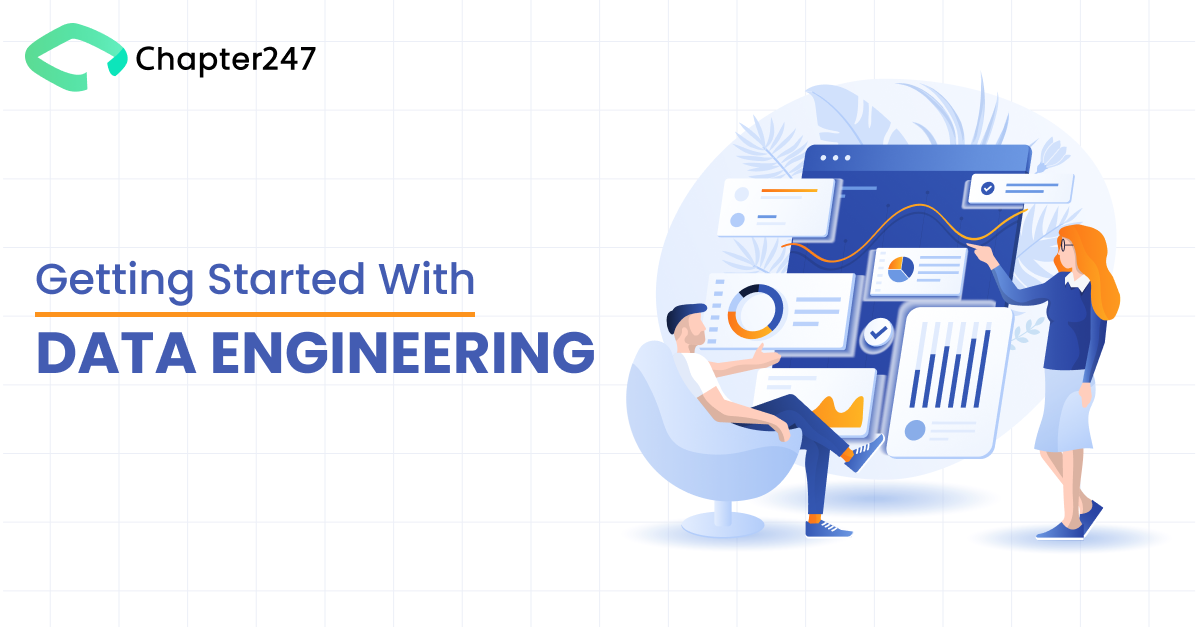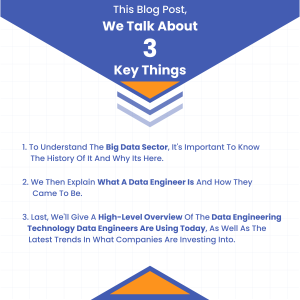Data Engineering is the process of designing & building systems for collecting, storing, and analyzing data at a large scale. It covers a wide variety of industries and can be applied to just about anything. Organizations can collect a lot of data, and they need the right team & technology to make sure it’s in a usable format when it reaches their team of data scientists & analysts.
Data scientists will be able to get more done in less time with artificial intelligence, and data engineers can make a tangible difference by helping to create machine-learning models that will enable businesses to operate more efficiently. By 2025 we’ll be producing around 463 exabytes daily. The amount of data we have needs engineers to do something with it. Without data engineers, massive fields like machine learning and deep learning won’t exist.
This Blog post, we talk about 3 key things:
- To understand the big data sector, it’s important to know the history of it and why it’s here.
- We then explain what a data engineer is and how they came to be.
- Last, we’ll give a high-level overview of the data engineering technology data engineers are using today, as well as the latest trends in what companies are investing into.
What is Big Data?
Marketing has made ‘Big Data’ seem completely out of touch at this point so it is refreshing to see a newer term gaining popularity.
It essentially boils down to – Datasets got so huge (Petabytes) that they couldn’t be served from a single machine (with commodity hardware) running an RDBMS (like mySQL, SQLServer, etc). This resulted in new technologies being invented to handle this such as NoSQL.
You have to realize that with the current limitations on processing speed and capacity, it becomes difficult to increase the quality of your machine just by getting hardware upgrades. As a result, many new technology solutions focus on distributing processing and storage load over a large pool of machines (known as “scaling out” or “horizontal scaling”)
What is a Data Engineer?
You can tell data engineers apart from software developers/engineers in the same way web/android developers are different. Data engineers know a lot about building software but they often have more specialized knowledge in a specific technology. The duties of a data engineer are wide-ranging, but focus on developing and testing large-scale databases. The job of a data scientist is more tightly defined and usually involves in-depth analysis.
Data engineers usually have a programming background and Data scientists typically come from a very mathematical background. The data engineer’s job is to make sure that the architecture of a data pipeline supports the needs of the stakeholders & data analysts.
Fundamentals & Ongoing Trends
Studying computer science and data engineering is crucial if you want to pursue a career in data engineering. In this field, you will see that many technological capabilities are centered around concurrency and distributed computing.
There are 3 key attributes in big data architecture namely Scalability, Scalability, and Scalability. One of the most important aspects in data engineering is trying to improve it. You can say that many of the technological trends lately have been influenced and constructed in a way to try to improve said aspect.
Such “trends” include:
- NoSQL databases are fairly new. They were created to solve the fundamental problem of scalability faced by relational databases due to their rigid limitations.
- As the prevalence of computers increases, computer science and information processing has become more complex. Functional programming principles are designed to make it easier to solve difficult problems that involve working with a lot of data at one time.
The Big Data Landscape
As a data engineer we mainly work with the open source section and to a lesser extent infrastructure. Let’s go over some of the technologies and their specific strengths & weaknesses.
Hadoop
There’s a reason this article is titled like it is. As you read on, it will probably start to feel like a guide about big data and Hadoop together. That’s not surprising given the fact that Hadoop has been and still remains an integral part of the analytics field. Hadoop is not the be-all and end-all of big data. It’s worth thinking about what you need your data for and how much capacity Hadoop offers before committing to it.
When someone says “we’re using Hadoop to build this system” they may actually be talking about one or all of the modules namely:
- Hadoop Common
- Hadoop Distributed File System (HDFS)
- Hadoop YARN
- Hadoop MapReduce
Spark
JavaScript is typically a fast-moving language and you know what that means: challenges at work every day. Data science isn’t as quick, but organizations are always evolving and new technologies emerge.
The technology that has caused a big shakedown in the field since open-sourcing Hadoop, is Apache Spark. It minimizes the management and processing of huge amounts of data and has largely superseded “Hadoop MapReduce” in batch data processing. Spark Core is the central component of Spark and provides all-purpose data processing functionality. It’s also got additional libraries for things like live data processing or machine learning.
Hive
Hive is a high-level query language for querying data stored in HDFS. It allows you to write SQL queries (specifically HiveQL – Hive Query Language) against the datasets. SQL commands are translated into other compatible systems, which can then be executed at some level by Hadoop or Tez. Depending on the form of your input, YARN may be employed for execution.
Hive is limited to on-line analytics processing and shouldn’t be used for real-time transactions as part of an OLTP system.
Zookeeper
Zookeeper is a service that runs inside your Hadoop cluster that keeps track of information which must be synchronized across all nodes in the network. It’s not tightly coupled to just Hadoop and can be used in any distributed system. Information such as:
- Which node is the master?
- What tasks are assigned to which workers?
- Which workers are currently unavailable?
Zookeeper is a common tool that can be used by any application within a Hadoop cluster. It is used by MapReduce, Spark among other applications.
Non-Relational (noSQL) Databases
It’s possible that your database will end up serving millions of customers. To handle this, you’ll be needing an even more powerful server than the small one you have. This need to scale horizontally to multiple servers has led to the development of “NoSQL” databases. For larger firms, consistency is more important than availability.
Below is the list of some most popular noSQL database choices:
- Hbase (CP)
- MongoDB (CP)
- Cassandra (AP)
- DynamoDB (AP)
Relational Databases
Relational databases are perfect for organizations with up to millions of customers. For anything else, a tool like Hadoop will make it easy to transfer data around.
Popular relational databases include:
- mySQL
- postgreSQL
- MariaDB
Roles & Responsibilities
The type of work a data engineer performs can vary from company to company. Some engineers do more coding-heavy work, while others may spend more time doing data cleansing or managing databases.
As a Data Engineer you may be involved in various projects such as the following:
- Building ETL (Extract-Transform-Load) pipelines: Don’t confuse ETL pipelines with data ingestion. Data ingestion is just transferring data from one location to another, while an ETL pipeline is a key component of any enterprising data system. They extract information from various sources, transform it, and load it all into your data warehouse. These systems are built from scratch using programming languages such as Python, Java, Scala, Go, etc. The computers build a model of the data and use various algorithms to process the inputs and come up with a prediction.
- Building metric analysis tools: Tools that allow you to see effectively how much your business is growing, customer engagement, etc.
- Building/Maintaining Data Warehouse/Lake: Data engineers are the data librarians that care for the other people in your company. They come up with a plan on how to keep everything organized and together.
Conclusion
 We hope this has proved to be an insightful introduction to data engineering. Data Engineering strategy differs a lot depending on the company’s industry, challenges, and demands. We specialize in all sorts of programming languages & provide the transformation service that fulfills your business needs. Click here to learn more about us!
We hope this has proved to be an insightful introduction to data engineering. Data Engineering strategy differs a lot depending on the company’s industry, challenges, and demands. We specialize in all sorts of programming languages & provide the transformation service that fulfills your business needs. Click here to learn more about us!








